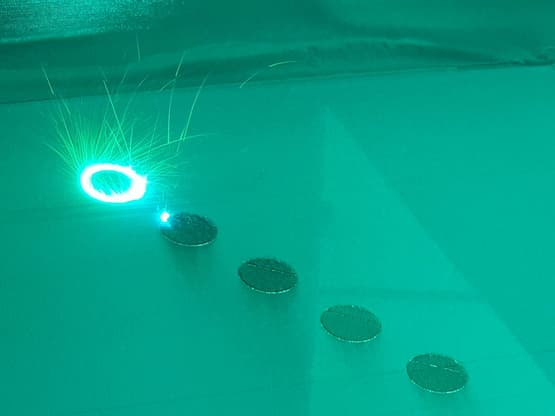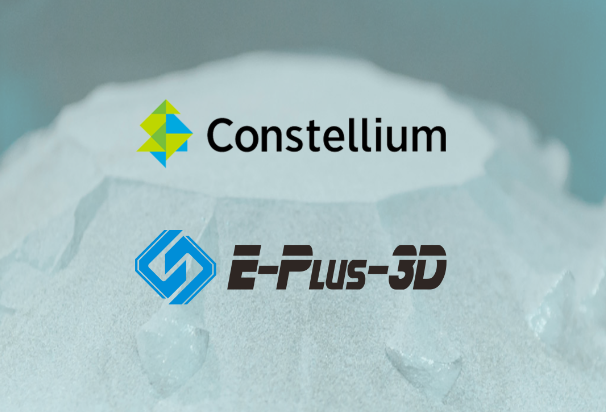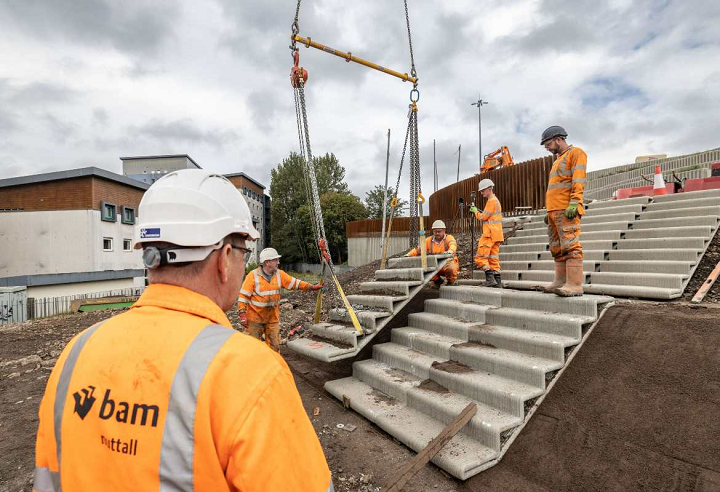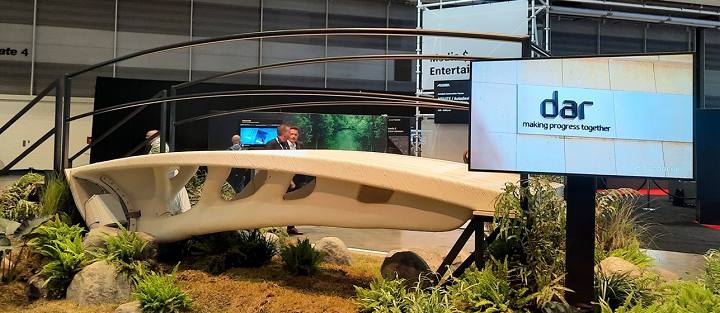In today’s 3D Printing News Briefs, we’re starting with research out of the Fraunhofer Institute for Manufacturing Engineering and Automation on 3D printing sensors in a single operation, and then on to research from Monash University about 3D printing an ultra strong commercial titanium alloy. Eplus3D developed a high-quality metal 3D printing process for Constellium’s Aheadd CP1 aluminum alloy. Finally, in construction news, BAM installed the first 3D printed concrete staircase in Scotland, and Autodesk Research partnered with Dar to build a smart bridge.
Fraunhofer IPA 3D Printing Electronic Devices in Single Operations
 LED demonstrator with integrated circuit board, printed TPE track, contacted LED and insulating PBT housing. (Image: Rainer Bez, Fraunhofer IPA)
LED demonstrator with integrated circuit board, printed TPE track, contacted LED and insulating PBT housing. (Image: Rainer Bez, Fraunhofer IPA)A team of researchers from the Fraunhofer Institute for Manufacturing Engineering and Automation (IPA) developed a way to 3D print sensors and other electronic devices in a single operation, through the use of conductive plastics. The team, with Fraunhofer IPA’s Center for Additive Manufacturing Technologies, 3D printed inductive proximity sensors in a variety of shapes, though the process had to be stopped multiple times to lay the conductor tracks in the housing. In phase two of the project, the team partnered with Arburg to determine which conductive plastics, instead of silver or copper, could be used, and experimented with different thermoplastic elastomers (TPE), which are conductive if they have enough carbon black particles.
After determining the TPE with the lowest electrical resistance for the greatest amount of possible applications, the team tested the material by exposing it to heat and cold, passed current through it at increasingly higher voltages, and artificially aged and stretched it to see how conductivity would be affected under age and tension. Additionally, the researchers also needed to determine the proper settings for Arburg’s Freeformer AM system, to see whether a horizontal or vertical print orientation affects the completed components’ conductivity. To achieve its purpose, conductive TPE must be embedded in another thermoplastic with insulating properties during 3D printing so they can bond, but not smear. Possible applications for the research team’s work include capacitive sensors, like level gauges or touch switches, and orthoses that release heat to support healing.
Monash Engineers 3D Printing Ultra-Strong Titanium Alloy
A published study, led by engineers at Monash University, explained how a 3D printing method was used to create an ultra-strong commercial titanium alloy, which they say has the highest strength-to-weight ratio of any 3D printed metal to date. Titanium alloys are the top 3D printed metal component in the aerospace industry, but most commercially 3D printed ones have inadequate properties for many structural applications. These researchers used 3D printing to manipulate a novel microstructure, which resulted in “unprecedented mechanical performance” and could represent a major leap forward for aerospace, defense, energy, and biomedical sectors. Their findings are expected to lead to insights into the principles of strengthening and dislocation engineering in physical metallurgy, and can be applied immediately.
“Titanium alloys require complex casting and thermomechanical processing to achieve the high strengths required for some critical applications. We have discovered that additive manufacturing can exploit its unique manufacturing process to create ultrastrong and thermally stable parts in commercial titanium alloys, which may be directly implemented in service,” explained Professor Aijun Huang.
“After a simple post-heat treatment on a commercial titanium alloy, adequate elongation and tensile strengths over 1,600 MPa are achieved, the highest specific strength among all 3D printed metal to date. This work paves the way to fabricate structural materials with unique microstructures and excellent properties for broad applications.”
Eplus3D Developed Metal AM Process for Aheadd CP1 Alloy
Laser powder bed fusion (LPBF) 3D printer manufacturer Eplus3D has developed a high-quality LPBF process for the Aheadd CP1 aluminum alloy commercialized by Constellium (NYSE: CSTM), a global manufacturer of aluminum rolled products, extruded products, and structural parts based on a variety of advanced alloys. Both companies believe that this development will enable users of 3D printed aluminum components in the aerospace, automotive, and packaging markets, as well as others, to design new applications, benefit from lowering the cost of production, push the boundaries of current business cases, and increase productivity for better ROI.
Designed specifically for LPBF processes, the Aheadd CP1 alloy features thermal conductivity and strength, and its silicon-free chemistry allows for high-quality anodization for 3D printed components; this will be especially useful in semiconductor equipment manufacturing. Additionally, its high productivity makes it a great solution for applications that require scalability and major cost reduction for series production. Eplus3D’s large-scale, multi-laser metal systems are able to achieve impressive print quality of average density, and the high ductility of Constellium’s Aheadd CP1 in its as-built state will allow the manufacturer’s customers to print large components with little geometrical distortion.
Scotland’s First Concrete 3D Printed Staircase Installed for Glasgow Bridge
The first contractor in Scotland to use 3D concrete printing (3DCP) is BAM, as it’s installed the staircase that will provide access to the new Sighthill Bridge across the M8 in Glasgow, which is believed to be the UK’s largest 3D printed construction to date. BAM, which is working on behalf of the Glasgow City Council, recently craned in the new staircase, which was printed by Weber Bemix in its Dutch factory before being shipped to Scotland. Once fully installed, the 3D printed steps will be clad in granite for a long-lasting, slip-free, and attractive finish, and will be just as strong as if poured onsite. By using 3D printing to build the staircase and bridge, precise and intricate shapes can be achieved to create a unique structure, and waste is reduced by 40% in removing unnecessary molds and materials, which also keeps costs down. Once completed, the pedestrian and cycle bridge will connect Glasgow City Centre to the Sighthill area in a new sustainable transport corridor.
“It’s wonderful to see these 3D Concrete printed aspects installed as this iconic bridge takes shape. The printed element saw us manufacture the stairwells offsite, creating strong, one-of-a-kind structures, all while reducing waste and interaction with weather and other elements which can create hold ups,” said Ian Steele, BAM Contracts Manager, M8 Footbridge.
“Although this part of the landscaping will ultimately be hidden from site, it marks a huge step forward for BAM in how we modernise our approach to construction – reducing risk, improving efficiency, and driving down our carbon footprint.
“The use of this technology is in its infancy, but the aspiration is that interest and application grow to such a degree that we can invest in a UK based printing facility which would improve how we construct within the UK.”
https://youtu.be/lBf1HhfPwcY
Autodesk Research and Dar Build A Smart Bridge
Finally, Autodesk Research and Dar, an international multidisciplinary consulting organization, recently revealed a 5-meter smart bridge that combines artificial intelligence, 3D printing, generative and parametric design, advanced robotics, recycled polymer materials, and sensing technologies. The two successfully manufactured the bridge, which shares critical data with a digital twin and builds on the success of their award-winning 2-meter Smart Bridge proof of concept. The objective of the joint project was to test out 3D printing technologies workflows, and materials in order to facilitate effective, sustainable 3D printing of bridges, buildings, and other large-scale infrastructure.
Recycled PETG and glass fiber were used to print the single-propped cantilevered bridge, and it’s composed of 70% recycled material. One of the lessons learned the team took from the first smart bridge printing it at an angle, which offers more flexibility and reduces the time needed to print a single layer. Additionally, while the first bridge was printed as a hollow structure, this one features an infill that mimics bone structure and functions as a lattice assembly. They used parametric design to optimize the gyroid infill pattern in order to minimize additional weight and maximize stiffness. FBG sensors were integrated into the deck, while traditional strain gauges were integrated in the support, to offer continuous data on the health and performance of the bridge. This data is transmitted to, and represented on, a digital twin platform, which conveys the real-time conditions of the bridge. You can learn more in the video found here.
Subscribe to Our Email Newsletter
Stay up-to-date on all the latest news from the 3D printing industry and receive information and offers from third party vendors.
You May Also Like
Gorilla Sports GE’s First 3D Printed Titanium Cast
How do you help a gorilla with a broken arm? Sounds like the start of a bad joke a zookeeper might tell, but it’s an actual dilemma recently faced by...
Nylon 3D Printed Parts Made More Functional with Coatings & Colors
Parts 3D printed from polyamide (PA, Nylon) 12 using powder bed fusion (PBF) are a mainstay in the additive manufacturing (AM) industry. While post-finishing processes have improved the porosity of...
$25M to Back Sintavia’s Largest Expansion of Metal 3D Printing Capacity Since 2019
Sintavia, the digital manufacturing company specializing in mission-critical parts for strategic sectors, announced a $25 million investment to increase its production capacity, the largest expansion to its operations since 2019....
Velo3D Initiates Public Offering in a Bid to Strengthen Financial Foundations and Drive Future Growth
Velo3D (NYSE: VLD) has been among a number of publicly traded 3D printing firms that have attempted to weather the current macroeconomic climate. After posting a challenging financial report for 2023,...



































